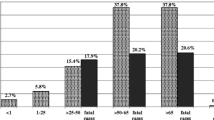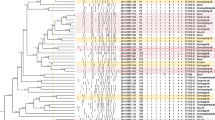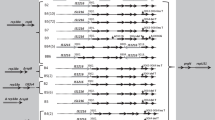Abstract
Background
Outbreaks of vancomycin-resistant Enterococcus faecium (VRE) strains is an emerging problem worldwide. Even if still relatively uncommon in European hospitals, infections caused by VRE have also been increasing recently in this continent.
Methods
In this study, we characterized 50 consecutive VRE and 23 vancomycin-sensitive E. faecium (VSE) isolates collected in an Italian hospital. The presence of the esp gene and that of genes encoding resistance to glycopeptides was investigated by polymerase chain reaction (PCR). All of the isolates were typed by multi-locus sequence typing (MLST), and a selection of them also by pulsed-field gel electrophoresis (PFGE).
Results
We found that all of the VRE and 18 (78%) of the VSE strains belonged to the single clonal complex-17 (CC17). The most represented sequence type (ST) was ST78 (34% of the isolates). When further analyzed by PFGE, ST78 isolates were subdivided into five pulsotypes, four of them closely related. The strong association between the esp gene and CC17 was confirmed. Interestingly, such an association was higher among vancomycin-resistant isolates. Most of the esp-positive isolates (34/46, 74%) encoded Esp4, a rare variant of this protein characterized by the absence of A repeats.
Conclusions
Our findings underscore the role of the CC17 lineage in the nosocomial spread of VRE and VSE, and its rapid local evolution, underscoring the need for programs designed to provide early detection in order to prevent its spreading among the nosocomial population.


Similar content being viewed by others
References
Uttley AH, Collins CH, Naidoo J, et al. Vancomycin-resistant enterococci. Lancet. 1988;1:57–8.
Werner G, Coque TM, Hammerum AM, et al. Emergence and spread of vancomycin resistance among enterococci in Europe. Euro Surveill 2008;13. pii: 19046
Klare I, Konstabel C, Mueller-Bertling S, et al. Spread of ampicillin/vancomycin-resistant Enterococcus faecium of the epidemic-virulent clonal complex-17 carrying the genes esp and hyl in German hospitals. Eur J Clin Microbiol Infect Dis. 2005;24:815–25.
Henwood CJ, Livermore DM, Johnson AP, et al. Susceptibility of gram-positive cocci from 25 UK hospitals to antimicrobial agents including linezolid. The Linezolid Study Group. J Antimicrob Chemother. 2000;46:931–40.
Lambiase A, Del Pezzo M, Piazza O, et al. Typing of vancomycin-resistant Enterococcus faecium strains in a cohort of patients in an Italian intensive care unit. Infection. 2007;35:428–33.
Theilacker C, Jonas D, Huebner J, et al. Outcomes of invasive infection due to vancomycin-resistant Enterococcus faecium during a recent outbreak. Infection. 2009;37:540–3.
Werner G, Klare I, Fleige C, et al. Increasing rates of vancomycin resistance among Enterococcus faecium isolated from German hospitals between 2004 and 2006 are due to wide clonal dissemination of vancomycin-resistant enterococci and horizontal spread of vanA clusters. Int J Med Microbiol. 2008;298:515–27.
Willems RJ, Top J, van Santen M, et al. Global spread of vancomycin-resistant Enterococcus faecium from distinct nosocomial genetic complex. Emerg Infect Dis. 2005;11:821–8.
Shankar N, Lockatell CV, Baghdayan AS, et al. Role of Enterococcus faecalis surface protein Esp in the pathogenesis of ascending urinary tract infection. Infect Immun. 2001;69:4366–72.
Shankar V, Baghdayan AS, Huycke MM, et al. Infection-derived Enterococcus faecalis strains are enriched in esp, a gene encoding a novel surface protein. Infect Immun. 1999;67:193–200.
Tendolkar PM, Baghdayan AS, Shankar N, et al. The N-terminal domain of enterococcal surface protein, Esp, is sufficient for Esp-mediated biofilm enhancement in Enterococcus faecalis. J Bacteriol. 2005;187:6213–22.
Shankar N, Baghdayan AS, Gilmore MS. Modulation of virulence within a pathogenicity island in vancomycin-resistant Enterococcus faecalis. Nature. 2002;417:746–50.
Leavis H, Top J, Shankar N, et al. A novel putative enterococcal pathogenicity island linked to the esp virulence gene of Enterococcus faecium and associated with epidemicity. J Bacteriol. 2004;186:672–82.
Valdezate S, Labayru C, Navarro A, et al. Large clonal outbreak of multidrug-resistant CC17 ST17 Enterococcus faecium containing Tn5382 in a Spanish hospital. J Antimicrob Chemother. 2009;63:17–20.
Bonora MG, Ligozzi M, De Fatima M, et al. Vancomycin-resistant Enterococcus faecium isolates causing hospital outbreaks in northern Italy belong to the multilocus sequence typing C1 lineage. Microb Drug Resist. 2004;10:114–23.
Bonora MG, Olioso D, Lo Cascio G, et al. Phylogenetic analysis of vancomycin-resistant Enterococcus faecium genotypes associated with outbreaks or sporadic infections in Italy. Microb Drug Resist. 2007;13:171–7.
Stampone L, Del Grosso M, Boccia D, et al. Clonal spread of a vancomycin-resistant Enterococcus faecium strain among bloodstream-infecting isolates in Italy. J Clin Microbiol. 2005;43:1575–80.
Zhu X, Zheng B, Wang S, et al. Molecular characterisation of outbreak-related strains of vancomycin-resistant Enterococcus faecium from an intensive care unit in Beijing, China. J Hosp Infect. 2009;72:147–54.
Hsieh YC, Lee WS, Ou TY, et al. Clonal spread of CC17 vancomycin-resistant Enterococcus faecium with multilocus sequence type 78 (ST78) and a novel ST444 in Taiwan. Eur J Clin Microbiol Infect Dis 2010;29:25–30.
Ko KS, Baek JY, Lee JY, et al. Molecular characterization of vancomycin-resistant Enterococcus faecium isolates from Korea. J Clin Microbiol. 2005;43:2303–6.
Standards, NCCLS. Methods for dilution antimicrobial susceptibility tests for bacteria that grow aerobically. Approved standard M7-A5. Wayne, PA, 2001.
Dutka-Malen S, Evers S, Courvalin P. Detection of glycopeptide resistance genotypes and identification to the species level of clinically relevant enterococci by PCR. J Clin Microbiol. 1995;33:24–7.
Leavis HL, Willems RJ, Top J, et al. Epidemic and nonepidemic multidrug-resistant Enterococcus faecium. Emerg Infect Dis. 2003;9:1108–15.
Homan WL, Tribe D, Poznanski S, et al. Multilocus sequence typing scheme for Enterococcus faecium. J Clin Microbiol. 2002;40:1963–71.
Murchan S, Kaufmann ME, Deplano A, et al. Harmonization of pulsed-field gel electrophoresis protocols for epidemiological typing of strains of methicillin-resistant Staphylococcus aureus: a single approach developed by consensus in 10 European laboratories and its application for tracing the spread of related strains. J Clin Microbiol. 2003;41:1574–85.
Tenover FC, Arbeit RD, Goering RV, et al. Interpreting chromosomal DNA restriction patterns produced by pulsed-field gel electrophoresis: criteria for bacterial strain typing. J Clin Microbiol. 1995;33:2233–9.
Leavis HL, Bonten MJ, Willems RJ. Identification of high-risk enterococcal clonal complexes: global dispersion and antibiotic resistance. Curr Opin Microbiol. 2006;9:454–60.
Top J, Schouls LM, Bonten MJ, et al. Multiple-locus variable-number tandem repeat analysis, a novel typing scheme to study the genetic relatedness and epidemiology of Enterococcus faecium isolates. J Clin Microbiol. 2004;42:4503–11.
Acknowledgments
The authors wish to thank Rob J.L. Willems and Janetta Top for the helpful discussion. This work was supported by the Veneto Region.
Conflict of interest
None.
Author information
Authors and Affiliations
Corresponding author
Rights and permissions
About this article
Cite this article
Fallico, L., Boldrin, C., Grossato, A. et al. Molecular epidemiology of Enterococcus faecium isolates from an Italian hospital. Infection 39, 127–133 (2011). https://doi.org/10.1007/s15010-011-0086-8
Received:
Accepted:
Published:
Issue Date:
DOI: https://doi.org/10.1007/s15010-011-0086-8




